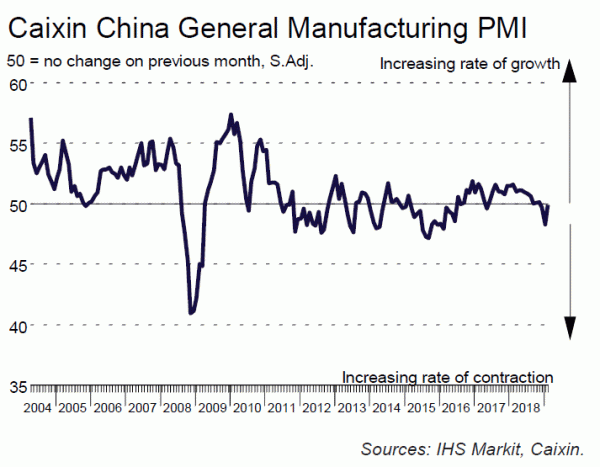China Caixin PMI manufacturing rose to 49.9 in February, up from 48.3 and beat expectation of 48.7. The key points are “renewed rise in output as total new business picks up, “backlogs continue to rise, but employment trend remains subdued”, and “selling prices increase for first time in four months”.
Commenting on the China General Manufacturing PMI™ data, Dr. Zhengsheng Zhong, Director of Macroeconomic Analysis at CEBM Group said:
“The Caixin China General Manufacturing PMI picked up to 49.9 in February from a recent low of 48.3 in the previous month, pointing to an easing of the economic downturn.
“The subindex for new orders returned to expansionary territory in February after staying in contraction for two months. Despite slipping back into contractionary territory following a rise the month before, the gauge for new export orders hit its second highest level since March 2018. Domestic manufacturing demand improved significantly, and foreign demand was not deteriorating as quickly as last year.
“The output subindex also returned to positive territory. The employment subindex dropped slightly further into negative territory, suggesting no sharp rise in pressure on the job market. The measure for stocks of finished goods fell further into negative territory, and reached its lowest level since May 2016. The subindex for stocks of purchased items picked up despite staying in negative territory, indicating a marginal recovery in manufacturers’ willingness to replenish their inventories. The subindex for suppliers’ delivery times fell further into negative territory, indicating mounting pressure on their capital turnover.
“Both gauges for input costs and output charges picked up, while the one for output charges rose more notably, implying that year-on-year growth in the producer price index was likely to have picked up slightly in February.
“Overall, with the early issuances of local governments’ special-purpose bonds and targeted adjustments to monetary policy, the situation in the manufacturing sector recovered markedly in February due to the effect of increased infrastructure investment. Prices of industrial products also picked up due to improving demand and the rebound in international commodity prices. However, the pressure on manufacturers’ capital turnover became obvious again, which may reflect that the financing environment was not easing as expected, and the effect of credit expansion is not yet significant.”













